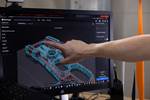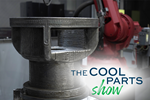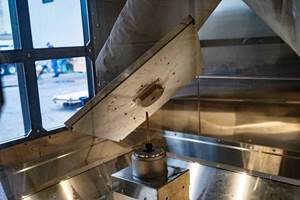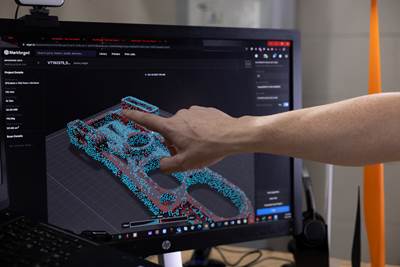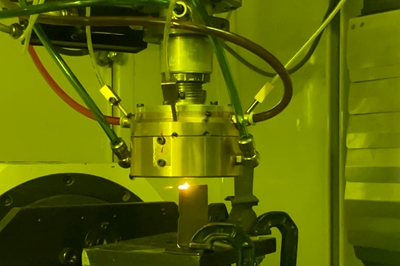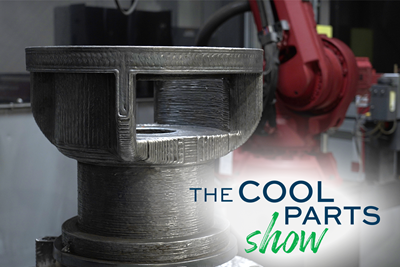In Rentaria, Spain, I got to see a major, successful system for large-scale component repair via additive manufacturing. A maker of wind power equipment needed a more effective way to repair its systems’ main shafts. Cold spray sometimes works to repair worn bearing areas on the shafts, but not reliably so. Scrapping a shaft and replacing it represents an expense of 140,000 euro — the company sought to avoid this expense. The successful solution seen in this video was developed by companies in Spain’s INZU Group including Ikergune, Izadi and Talens. A robot delivers precise directed energy deposition of Inconel 625 to repair the steel shaft. The video describes process elements beyond the material deposition needed for the success of this system, including a high-volume hopper to assure continuous powder flow over long production time, cooling of key system components, and a solution for heating the shaft ahead of deposition to optimize the interface zone between the two metals.
Transcript
Peter Zelinski
Additive manufacturing. As it advances, we see new components, new parts that could only be made through 3D printing. But another possibility is becoming prominent, and it relates to old components, existing parts, the chance to keep them in service longer by restoring them, repairing them, saving significant cost. I saw an amazing example of this in Renteria, Spain, that I want to share with you. Some companies that are all part of the INZU Group of companies: the ones we'll hear from are Izadi and Talens Systems. They're working on this repair system for very large shafts. A wind power OEM came to Izadi looking for this solution. Izadi is a machine shop, machine builder specializing in really big machinery, big components like big gears, big shafts. To get us started here from Izadi is Diego Navamuel.
Diego Navamuel, Izadi
OEM requires the repair process by laser directed energy deposition of the main shaft since manufacturing a brand new shaft costs more than 140,000 euros. The wear is due to the shaft’s service operation time. The bearings where the shaft is assembled wears the shaft.
Peter Zelinski
So these big shafts for wind turbines they wear in the bearing areas. Sometimes cold spray provides a repair opportunity, but more often the shafts have been scrapped altogether, replaced with new shafts. The cost is around €140,000. Additive manufacturing can save that expense. Talens Systems is the laser material deposition specialist. They're good at directed energy deposition, for example. Their contribution to this shaft repair system is this robotic DED solution, a large Kuka robot carrying a deposition head for applying Inconel 625 material to repair these steel shafts. But it's more complicated than that. From Talens Systems, here is Itziar Onandia.
Itziar Onandia, Talens Systems
Each shaft weighs approximately 22 tons and it's 3.3m long. The approximate dimensions of the area to repair it by coating with Inconel 625 are: The first one has a length of 650mm and a diameter of 930mm. And the second bearing area has a length of 400mm and a diameter of 820mm. The base material of the shaft is 42CrMo4, and according to the OEM specifications, the material used for the repairing, as I said before, is Inconel 625. The coating process of each bearing area lasts 12 hours nonstop, with a powder flow rate of 25g per minute. It consists of three layers of material deposition, having each layer a height of 0.6 to 0.8mm. The 12 hours nonstop is possible thanks to our proprietary and patent pending automatic refilling hopper, and also the thermal shields designed and developed to protect the robotic optics, our sensors and the equipment.
Peter Zelinski
So when I was with the team in Spain, I got to talk to them about all the challenges they went through in getting to a repeatable industrial production system for this repair solution. This extension sleeve carries the deposition nozzle. It's also prone to heat transfer, heat transfer to such an extent that it was affecting the optics, the precision and the performance of the laser optics. It took a little while for the team to figure out that this component was the culprit for some problems they were seeing. So redesigning this sleeve to allow for internal cooling to control the temperature, that proved very important to the performance of this system. Here is a broader, bigger, system wide solution that they developed. It relates to powder delivery. So each of these bearing areas, to make the repair, it requires about 20kg of material, so about four of these canisters. There are two bearing areas per shaft. The intent is for this deposition system to run 24/7. It's a repair process, but it needs to be a production process too, repairing shaft after shaft. The flow rate of material in deposition is about 25g per minute. So how do you maintain that material flow, that controlled rate of material flow across what could be a pretty long unattended process?
Itziar Onandia
The material is melted during a 12 hour nonstop method. And this is possible thanks to our proprietary, automatic refilling hopper that has a capacity for 440kg, and it's designed for a 24/7 production rate. So several R&D activities have been necessary to design and develop this hopper, which guarantees a 24/7 powder supply. We ended up researching and designing a proprietary solution unique in the market and patent pending, that enables Talens to provide continuous powder flows of up to 200g per minute.
Peter Zelinski
So the innovation is in more than the deposition. Other concerns Talens Systems had to look at. Powder characterization. What aspects of the powder are the most important for assuring the flow ability they need for this system to work? A custom hopper solution that Talens developed. Software. Toolpath programing, for example. Getting just the right overlap between adjacent passes to build this repair surface exactly as needed. Melt pool monitoring for ongoing control of the system. Data capture. Getting ready for a potential additional user that might have even greater traceability needs, like an aerospace industry application, for example. Something else the team recognized early on: The most effective DED in this application would come from controlling the heat affected zone right at that juncture where the Inconel 625 meets the steel of the shaft. And to control that heat affected zone, that meant heating the surface first prior to material deposition. So how do you heat a shaft that big? Well, here is the shaft pre-heater that Izadi invented.
Diego Navamuel
This step is necessary to ensure that the heat affected zone is below 400 hardness Vickers. It has been designed at Izadi facilities and manufactured internally and with local suppliers.
Peter Zelinski
The shaft goes in that heater for about eight hours prior to DED. The pink pieces you see are the heating elements. Ceramic. Induction heating would have been a possibility. This heater is less expensive than that. So key points. Additive manufacturing as a repair solution, in this case potentially saving significant cost. But to get to a solution like this, it’s more than 3D printing, more than laying on material. This is production too. In a context like this, repair is production. The intent is a system that can run continuously. So to get to that, it meant system engineering, providing for all of the consistency and repeatability needed to run and rely on this process. But the team involved in this solution, they got there. This solution has been realized and deployed.
Diego Navamuel
There are conversations going on, but more or less this can be in a pre-industrialization phase repairing 20-30 shafts per year. In a full industrialization phase, this can be repairing more than 50 shafts per year.
Peter Zelinski
And Izadi is marketing, adapting this system to other potential users who might have similar repair applications. Thank you Izadi for letting me visit, see this system, understand it. For even more Talens Systems, the laser material deposition specialist, I saw another solution they're working on, a very different solution not related to repair. Talens Systems is also involved in developing a new means of manufacturing automotive brake discs involving 3D printing. I saw that solution as well. And a future video like this will cover that application. Subscribe so you see that one when it drops.
Related Content
Video: 5" Diameter Navy Artillery Rounds Made Through Robot Directed Energy Deposition (DED) Instead of Forging
Big Metal Additive conceives additive manufacturing production factory making hundreds of Navy projectile housings per day.
Read MoreThe Cold Spray Solution to the Casting, Forging Supply Chains
Startup HAMR Industries performs additive manufacturing work at Neighborhood 91 that provides an alternative to traditional casting and forging. Success so far has led to redefining the limits of its additive equipment.
Read MoreNew Equipment, Additive Manufacturing for Casting Replacement and AM's Next Phase at IMTS 2024: AM Radio #54
Additive manufacturing’s presence at IMTS – The International Manufacturing Technology Show revealed trends in technology as well as how 3D printing is being applied today and where it will be tomorrow. Peter Zelinski and I share observations from the show on this episode of AM Radio.
Read MoreMachine Tool Drawbar Made With Additive Manufacturing Saves DMG MORI 90% Lead Time and 67% CO2 Emission
A new production process for the multimetal drawbar replaces an outsourced plating step with directed energy deposition, performing this DED along with roughing, finishing and grinding on a single machine.
Read MoreRead Next
3D Printing Increases Efficiency Of Wind Turbine Blade Alignment
A Markforged digital repository and 3D printers enable faster, more accurate and less costly manufacture of a variety of tools and blade components across Vestas sites.
Read MoreVideo: Additive Manufacturing for Aircraft Blade Repair
Optomec machines use directed energy deposition guided by optical measurement and automatic programming to repair aircraft engine blades. Here is a look at the 3D printing repair operation.
Read More500-Pound Replacement Part 3D Printed by Robot: The Cool Parts Show #50
Our biggest metal cool part so far: Wire arc additive manufacturing delivers a replacement (and upgrade) for a critical bearing housing on a large piece of industrial machinery.
Read More


